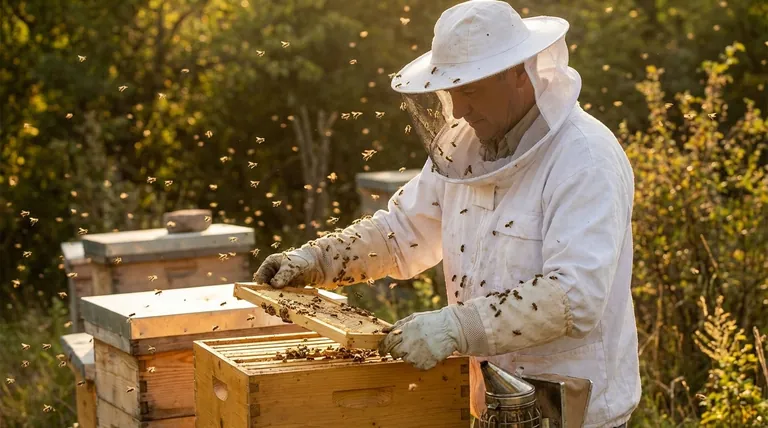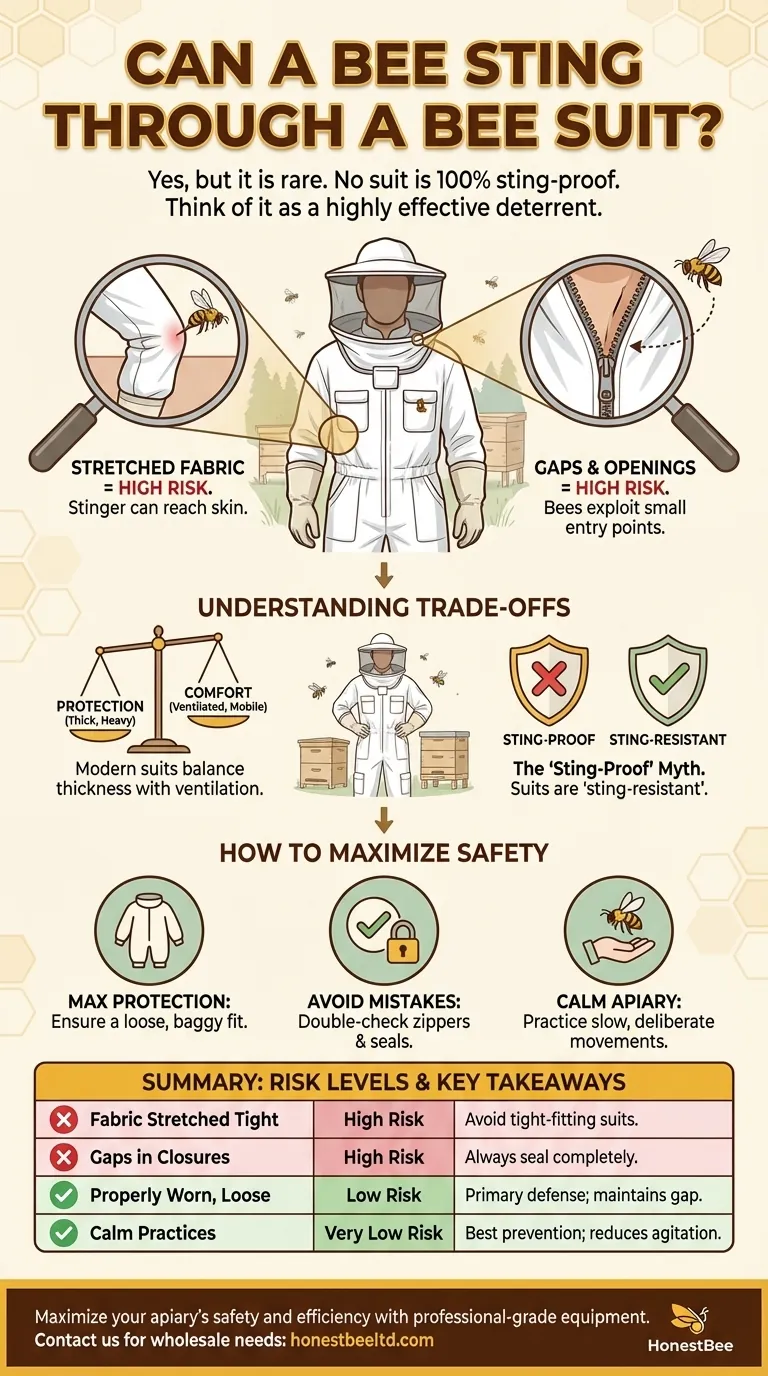Yes, a bee can sting through a bee suit. While it is not a common occurrence, no bee suit is 100% sting-proof. The fabric can be penetrated if it is stretched tightly against your skin, and persistent bees can find their way into small gaps in the suit's closures.
The purpose of a bee suit is not to provide absolute, impenetrable armor, but to drastically reduce the likelihood of stings. Think of it as a highly effective deterrent that turns a likely event into a rare exception.

How a Bee Suit's Protection Can Be Compromised
A high-quality bee suit provides excellent protection, but certain conditions can create vulnerabilities. Understanding these weak points is the key to using your suit effectively.
The Primary Weakness: Stretched Fabric
The most common way a bee stings through a suit is when the material is pulled taut against the body. This often happens at the knees when kneeling or at the elbows when bending your arms.
When the fabric is loose, there is a gap between the material and your skin that is longer than the bee's stinger. When it's tight, that protective gap disappears, allowing a stinger to potentially reach you.
Finding Gaps and Openings
Bees can be persistent and may exploit any small opening they can find. If a suit is not sealed properly, bees can get inside.
Common entry points include the zippers on the veil, the elastic at the wrists and ankles, or where the gloves meet the suit sleeves. A single forgotten zipper can compromise the entire suit.
Understanding the Trade-offs
The design of any bee suit is a deliberate balance between perfect protection and practical usability. Recognizing these trade-offs helps set realistic expectations.
Protection vs. Comfort
The most sting-proof suit would likely be thick, heavy, and extremely hot, making it impractical for working in the sun. Modern suits balance a protective thickness with materials that allow for ventilation and mobility.
The Myth of Being "Sting-Proof"
Reputable manufacturers will state that their suits are "sting-resistant," not "sting-proof." This honesty reflects the reality that under the right circumstances—like with stretched fabric or a highly agitated hive—a determined bee can occasionally get through.
The Beekeeper's Role in Prevention
Your behavior around the hive is a critical layer of protection that the suit itself cannot provide. Staying calm, moving slowly, and being considerate of the bees' temperament will dramatically reduce their defensive behavior. An agitated bee is far more likely to attempt to sting.
How to Maximize Your Safety
Your goal is to use the suit as an effective tool, and that means ensuring it's worn correctly and supplemented with calm beekeeping practices.
- If your primary focus is maximum protection: Choose a high-quality, thick suit and ensure you buy a size that provides a loose, baggy fit all over.
- If your primary focus is avoiding common mistakes: Always perform a pre-inspection, double-checking that every zipper is fully closed and all seals at the wrists and ankles are secure.
- If your primary focus is a calm apiary: Practice slow, deliberate movements and avoid agitating the bees, which is the best way to prevent them from becoming defensive in the first place.
Ultimately, a well-chosen and properly worn bee suit makes beekeeping a safe and enjoyable activity.
Summary Table:
| Scenario | Risk Level | Key Takeaway |
|---|---|---|
| Fabric Stretched Tight Against Skin | High | Creates a direct path for the stinger; avoid tight-fitting suits. |
| Gaps in Zippers or Closures | High | Persistent bees can exploit small openings; always seal completely. |
| Properly Worn, Loose-Fitting Suit | Low | The primary defense; maintains a protective gap between fabric and skin. |
| Calm Beekeeping Practices | Very Low | The best prevention; slow movements reduce bee agitation. |
Maximize your apiary's safety and efficiency with professional-grade equipment from HONESTBEE.
As a trusted wholesale supplier to commercial apiaries and distributors, we understand that your business depends on reliable, durable protection. Our bee suits and beekeeping supplies are designed with the professional in mind, balancing superior sting-resistance with the ventilation and mobility needed for long days in the field.
Ready to equip your team with gear you can trust? Contact HONESTBEE today to discuss your wholesale needs and discover how our equipment can contribute to a safer, more productive operation.
Visual Guide

Related Products
- Economy Polyester Beekeeping Jacket with Veil and Hat
- Beekeeping Jacket with Hood and Veil for Beekeepers
- Cotton Beekeeping Suit and Round Hat with Veil Bee Keeper Protective Gear
- White Beekeeping Protective Suit and Hat with Fencing Veil for Beekeepers
- Professional Beekeeping Suit for Kids and Girls Childrens Bee Keeper Suit
People Also Ask
- What are the advantages of using a beekeeping jacket instead of a full suit? Unlock Speed and Comfort
- What is a bee jacket and how does it differ from a full beekeeping suit? Choose the Right Protection for Your Apiary
- What are the features of an economical beekeeping jacket? Essential Protection for Budget-Conscious Beekeepers
- What should I wear under a bee suit? Essential Clothing for Maximum Protection & Comfort
- What are the pros of using a beekeeping jacket? Unlock Superior Comfort and Mobility for Your Apiary



















